List of extinct animals of Australia
Following is a list of Australian animal extinctions from the arrival of the first European colonists in 1788 (before the Aboriginal and prehistory extinctions) until the present. There are 24 birds (one from the mainland), seven frogs, and 27 mammal species or subspecies strongly believed to have become extinct in Australia since European settlement.
Extinctions are recorded under the Environment Protection and Biodiversity Conservation Act 1999.
Several invertebrate species have also been listed as extinct by the International Union for the Conservation of Nature (IUCN); however, this list is less exhaustive, as invertebrates are more difficult to survey and are less well studied.
Extinct Australian animals: 1788 to present
Birds
| Species | Common name | Location(s) | Comments | Pictures |
|---|---|---|---|---|
| Aplonis fusca | Tasman starling | Norfolk Island and Lord Howe Island, NSW | Last recorded in 1923. Competition from the introduced common starling, common blackbird and song thrush, clearance for agriculture and predation from introduced black rats. Among these dangerous predators, the Tasman starling always kept its distance.[1] |  |
| Columba vitiensis godmanae | White-throated pigeon (Lord Howe Island), Lord Howe pigeon | Lord Howe Island | Last recorded 1853. Believed due to hunting. |  |
| Cyanoramphus novaezelandiae subflavescens | Red-crowned parakeet (Lord Howe Island), Lord Howe parakeet | Lord Howe Island | Last recorded in 1869. Due to persecution because of predation on gardens and crops. |  |
| Dasyornis broadbenti litoralis | Western rufous bristlebird, rufous bristlebird (western), southwestern rufous bristlebird, lesser rufous bristebird | WA | ||
| Dromaius novaehollandiae minor | King Island emu, dwarf emu | King Island | 1822. Extinction due to hunting and, apparently, human-started brush fires. Two captive birds that died in 1822 were the last of their kind. | |
| Dromaius novaehollandiae baudinianus | Kangaroo Island emu, black emu | Kangaroo Island | 1827. Extinction has been attributed to hunting and human-started brush fires. | |
| Dromaius novaehollandiae diemenensis | Tasmanian emu | Tasmania | 1850. Extinction due to hunting and human-started brush fires; its status as a distinct subspecies is not universally accepted. | |
| Drymodes superciliaris colcloughi | Roper River scrub-robin | NT | Last recorded in 1910. This subspecies may be invalid. It is known from only two specimens of doubtful provenance.[2] | |
| Gallicolumba norfolciensis | Norfolk ground dove | Norfolk Island | the 1850s | 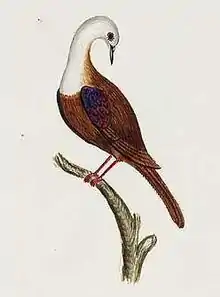 |
| Gerygone insularis | Lord Howe gerygone, Lord Howe warbler | Lord Howe Island | Not recorded since 1928. Believed to be a result of the introduction of black rats following the grounding of the SS Makambo in June 1918. |  |
| Hemiphaga novaeseelandiae spadicea | New Zealand pigeon (Norfolk Island subspecies) | Norfolk Island | 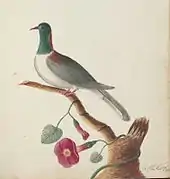 | |
| Lalage leucopyga leucopyga | Norfolk Island long-tailed triller | Norfolk Island | 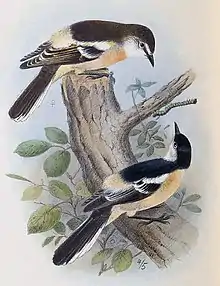 | |
| Nestor productus | Norfolk Island kaka | Norfolk Island | 1851 |  |
| Ninox novaeseelandiae albaria | Morepork (Lord Howe Island), Lord Howe boobook, Lowe Howe morepork | Lord Howe Island | the 1950s | 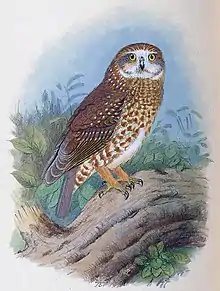 |
| Ninox novaeseelandiae undulata | Morepork (Norfolk Island), Norfolk boobook, Norfolk Island boobook, Norfolk Island morepork | Norfolk Island | 1996 |  |
| Porphyrio albus | White gallinule | Lord Howe Island |  | |
| Psephotus pulcherrimus | Paradise parrot | NSW, Qld | Date uncertain but around 1927; more recent sightings are sometimes claimed, but have never been confirmed. Cause uncertain, most hypotheses centre on starvation from lack of grass seed after drought, overgrazing, more frequent fires, and introduction of the prickly pear. |  |
| Rallus pectoralis clelandi | Western Lewin's rail, Lewin's rail (western), Lewin water rail, Cleland's rail | WA | Last recorded in 1932. | |
| Gallirallus philippensis macquariensis | Macquarie Island rail | Macquarie Island | ||
| Rhipidura cervina | Lord Howe fantail | Lord Howe Island | Not recorded since 1924. Believed to be a result of the introduction of black rats following the grounding of the SS Makambo in June 1918. | 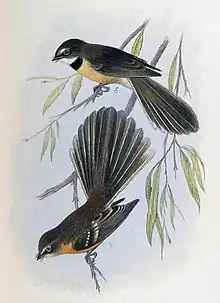 |
| Turdus poliocephalus poliocephalus | Norfolk Island thrush, grey-headed blackbird | Norfolk Island | 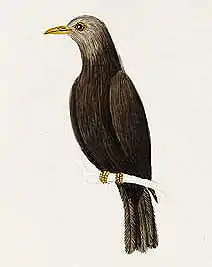 | |
| Turdus poliocephalus vinitinctus | Lord Howe Island thrush | Lord Howe Island | Not recorded since c. 1924. Believed to be a result of the introduction of black rats following the grounding of the SS Makambo in June 1918. | 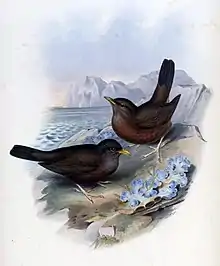 |
| Zosterops albogularis | White-chested white-eye, Norfolk Island silvereye | Norfolk Island | The IUCN considers this species endangered; it is listed as extinct under the EPBC act since it has not been officially documented for over 20 years. | 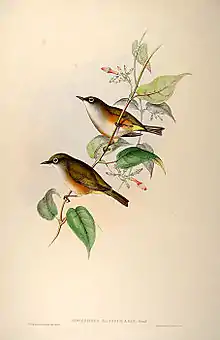 |
| Zosterops strenuus | Robust white-eye | Lord Howe Island | Not recorded since 1923. Believed to be a result of the introduction of black rats following the grounding of the SS Makambo in June 1918. | 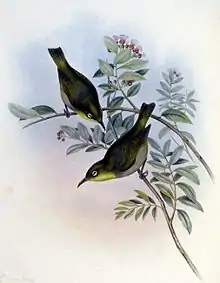 |
Amphibians
The reason for the decline and extinction of these frog species is unclear, decline in frog populations is an international phenomenon. 14 species are listed as critically endangered, and some of these may already be extinct.
| Species | Common name | Location(s) | Comments | Pictures |
|---|---|---|---|---|
| Rheobatrachus silus[3] | Gastric-brooding frog | Qld | The last wild specimen was recorded in 1981. | |
| Rheobatrachus vitellinus[4] | Eungella gastric-brooding frog | Qld | The last wild specimen was recorded in 1985. | |
| Taudactylus acutirostris[5] | Sharp-snouted day frog, sharp-snouted torrent frog | Qld | The last wild specimen was recorded in 1997. | |
| Taudactylus diurnus[6] | Mt. Glorious day frog, Mt. Glorious torrent frog, southern day frog | Qld | The last wild specimen was recorded in 1979. |
Reptiles
| Species | Common name | Location(s) | Comments | Pictures |
|---|---|---|---|---|
| Emoia nativitatis | Christmas Island forest skink | Christmas Island | The last captive specimen died on May 31, 2014[7] | |
| Tympanocryptis pinguicolla | Victorian grassland earless dragon | VIC | Possibly extinct; the last known wild specimen was recorded in 1969. If it is extinct, it may be the first recorded reptile extinction on mainland Australia.[8] | 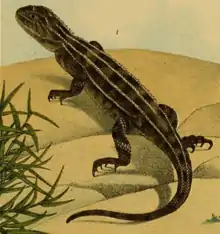 |
Mammals
| Species | Common name | Location(s) | Comments | Pictures |
|---|---|---|---|---|
| Bettongia penicillata penicillata | Brush-tailed bettong (southeastern mainland) | NSW, NT, SA, VIC, WA | ||
| Caloprymnus campestris[9] | Desert rat-kangaroo | Qld, SA, NT | 1935 | |
| Chaeropus ecaudatus[10] | Pig-footed bandicoot | NSW, NT, SA, VIC, WA | the 1950s | |
| Conilurus albipes[11] | White-footed rabbit-rat | NSW, Qld, SA, VIC | 1857 | |
| Lagorchestes asomatus[12] | Central hare-wallaby | NT | 1935 | |
| Lagorchestes hirsutus hirsutus | Rufous hare-wallaby (southwestern mainland) | NT, SA, WA | ||
| Lagorchestes leporides[13] | Eastern hare-wallaby | NSW, Qld, SA, VIC | 1890 | |
| Lagostrophus fasciatus albipilis[14] | Banded hare-wallaby (mainland) | WA | ||
| Leporillus apicalis[15] | Lesser stick-nest rat | NSW, NT, SA, VIC, WA | 1933 | |
| Macropus eugenii eugenii[16] | Tammar wallaby (South Australia) | SA | A surviving population was rediscovered in New Zealand. | 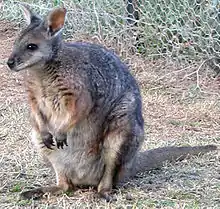 |
| Macropus greyi[17] | Toolache wallaby | SA, VIC | 1932 | |
| Macrotis leucura[18] | Lesser bilby | NT, Qld, SA | 1931 | |
| Melomys rubicola[19] | Bramble Cay melomys | Bramble Cay, QLD | 2016 | |
| Notomys longicaudatus | Long-tailed hopping-mouse | NT, SA, WA | 1901 | |
| Notomys macrotis[20] | Big-eared hopping-mouse | WA | 1843 | |
| Notomys mordax[21] | Darling Downs hopping-mouse | NSW, Qld | 1846 | |
| Onychogalea lunata[22] | Crescent nailtail wallaby | SA, WA | 1956 | |
| Perameles bougainville fasciata[23] | Western barred bandicoot (mainland) | NSW, VIC | ||
| Perameles eremiana[24] | Desert bandicoot | NT, SA, WA | <1960 | |
| Pipistrellus murrayi[25] | Christmas Island pipistrelle | Christmas Island | 2009 | |
| Potorous platyops[26] | Broad-faced potoroo | WA | 1865 | |
| Pseudomys glaucus[27] | Blue-grey mouse | NSW, Qld | 1956 | |
| Pseudomys gouldii[28] | Gould's mouse | NSW, Qld, SA, VIC, WA | 1857 | |
| Pteropus brunneus[29] | Dusky flying fox | Qld | the late 1800s |  |
| Rattus macleari[30] | Maclear's rat | Christmas Island | 1908 | |
| Rattus nativitatis[31] | Bulldog rat | Christmas Island | last recorded in 1903. | |
| Thylacinus cynocephalus[32] | Thylacine, Tasmanian wolf, Tasmanian tiger | Tasmania | 1936 |
Possibly extinct mammals
| Species | Common name | Location(s) | Comments | Pictures |
|---|---|---|---|---|
| Crocidura trichura[33] | Christmas Island shrew | Christmas Island | 1985 | |
| Nyctophilus howensis | Lord Howe long-eared bat | Lord Howe Island | ||
Invertebrates
Several Australian Invertebrates have been listed by the World Conservation Union as having become extinct. The first and only Australian invertebrate species officially listed is the Lake Pedder earthworm.[34]
| Species | Common name | Location(s) | Comments | Pictures |
|---|---|---|---|---|
| Hypolimnus pedderensis | Lake Pedder earthworm | Tas | Probably extinct in 1972, confirmed in 2000[35] | |
| Advena campbelli | Campbell's land snail | Norfolk Island | ||
| Nancibella quintalia | Norfolk snail | Norfolk Island | ||
| Tornelasmias capricorni | Lord Howe snail | [36] | ||
| Angrobia dulvertonensis | Macqaurie slug | 1996[37] | ||
| Placostylus bivaricosus etheridgei | Lord Howe slug | [38] |
Extinct Australian animals pre-European settlement (1788)
| Species | Common name | Location(s) | Comments | Pictures |
|---|---|---|---|---|
| Bowengriphus perphlegis | Bowengriphus | Queensland | ||
| Ebenaqua ritchei | Ebenaqua | Queensland | ||
| Megalania prisca or Varanus priscus | Megalania | Australia | 30,000 years b.p. | |
| Diprotodon opatum | Diprotodon | Australia | ||
| Procoptodon goliah | Giant short-faced kangaroo | Australia | ||
See also
- Fauna of Australia
- List of extinct animals
- Threatened fauna of Australia
References
- "Aplonis fusca — Tasman Starling". Environment.gov.au. Retrieved 16 August 2018.
- Schodde R, Mason IJ (1999). The Directory of Australian Birds: Passerines. A Taxonomic and Zoogeographic Atlas of the Biodiversity of Birds in Australia and its Territories. Collingwood, Australia: CSIRO Publishing. pp. x 851 pp. ISBN 0-643-06456-7.
- Ed Meyer; David Newell; Harry Hines; Sarah May; Jean-Marc Hero; John Clarke; Frank Lemckert (2004). "Rheobatrachus silus (Southern Gastric Brooding Frog, Southern Platypus Frog)". IUCN Red List of Threatened Species. 2004. Retrieved 30 December 2013.
- Jean-Marc Hero; Keith McDonald; Ross Alford; Michael Cunningham; Richard Retallick (2004). "heobatrachus vitellinus (Eungella Gastric-brooding Frog, Northern Gastric Brooding Frog)". IUCN Red List of Threatened Species. 2004. Retrieved 30 December 2013.
- Jean-Marc Hero; Keith McDonald; Michael Cunningham; Ross Alford; Richard Retallick (2004). "Taudactylus acutirostris (Sharp Snouted Day Frog)". IUCN Red List of Threatened Species. 2004. Retrieved 30 December 2013.
- Jean-Marc Hero; Sarah May; David Newell; Harry Hines; John Clarke; Ed Meyer (2004). "Taudactylus diurnus (Mount Glorious Day Frog, Mount Glorious Torrent Frog, Southern Day Frog)". IUCN Red List of Threatened Species. 2004. Retrieved 30 December 2013.
- John Woinarski, Don Driscoll and Hal Cogger, Vale ‘Gump’, the last known Christmas Island Forest Skink, The Conversation, 8 August 2014. Retrieved 6 December, 2015.
- Melville Jane; Chaplin Kirilee; Hutchinson Mark; Sumner Joanna; Gruber Bernd; MacDonald Anna J.; Sarre Stephen D. (2019). "Taxonomy and conservation of grassland earless dragons: new species and an assessment of the first possible extinction of a reptile on mainland Australia". Royal Society Open Science. 6 (5): 190233. Bibcode:2019RSOS....690233M. doi:10.1098/rsos.190233. PMC 6549961. PMID 31218062.
- Australasian Mammal Assessment Workshop (2008). "Caloprymnus campestris (Buff-nosed Rat-kangaroo, Desert Rat Kangaroo, Plains Rat-kangaroo)". IUCN Red List of Threatened Species. 2008. Retrieved 23 December 2013.
- Burbidge, A.; Dickman, C. & Johnson, K. (2008). "Chaeropus ecaudatus (Pig-footed Bandicoot)". IUCN Red List of Threatened Species. 2008. Retrieved 23 December 2013.
- Baillie, J.E.M. (2008). "Conilurus albipes (Rabbit-eared Tree-rat, White-footed Rabbit-rat, White-footed Rabbit Rat, White-footed Tree-rat)". IUCN Red List of Threatened Species. 2008. Retrieved 23 December 2013.
- Burbidge, A. & Johnson, K. (2008). "Lagorchestes asomatus (Central Hare-wallaby, Central Hare Wallaby, Least Hare-wallaby, Least Hare Wallaby)". IUCN Red List of Threatened Species. 2008. Retrieved 23 December 2013.
- Australasian Mammal Assessment Workshop (2008). "Lagorchestes leporides (Eastern Hare-wallaby, Eastern Hare Wallaby)". IUCN Red List of Threatened Species. 2008. Retrieved 23 December 2013.
- "Lagostrophus fasciatus albipilis — Banded Hare-wallaby (mainland)". Environment.gov.au. Australian Government Department of Environment. Retrieved 1 July 2015.
- Robinson, T. & Burbidge, A. (2016). "Leporillus apicalis (Lesser Stick-nest Rat, White-tipped Stick-nest Rat)". IUCN Red List of Threatened Species. 2016. Retrieved 7 June 2020.
- "Macropus eugenii eugenii — Tammar Wallaby (South Australia)". Environment.gov.au. Australian Government Department of Environment. Retrieved 17 September 2015.
- Australasian Mammal Assessment Workshop (2008). "Macropus greyi (Toolache Wallaby)". IUCN Red List of Threatened Species. 2008. Retrieved 23 December 2013.
- Burbidge, A.; Johnson, K. & Dickman, C. (2008). "Macrotis leucura (Lesser Bilby, Lesser Rabbit-eared Bandicoot, White-tailed Rabbit-eared Bandicoot, Yallara)". IUCN Red List of Threatened Species. 2008. Retrieved 23 December 2013.
- Slezak, Michael (14 June 2016). "Revealed: first mammal species wiped out by human-induced climate change". The Guardian. London. Retrieved 14 June 2016.
- Morris, K. & Burbidge, A. (2008). "Notomys macrotis (Big-eared Hopping-mouse, Big-eared Hopping Mouse)". IUCN Red List of Threatened Species. 2008. Retrieved 23 December 2013.
- Baillie, J.E.M. (2008). "Notomys mordax (Darling Downs Hopping Mouse)". IUCN Red List of Threatened Species. 2008. Retrieved 23 December 2013.
- Burbidge, A. & Johnson, K. (2008). "Onychogalea lunata (Crescent Nail-tailed Wallaby, Crescent Nailtail Wallaby, Wurrung)". IUCN Red List of Threatened Species. 2008. Retrieved 23 December 2013.
- "Perameles bougainville fasciata — Western Barred Bandicoot (mainland)". Environment.gov.au. Australian Government Department of Environment. Retrieved 1 July 2015.
- Burbidge, A.; Johnson, K. & Aplin, K. (2008). "Perameles eremiana (Desert Bandicoot)". IUCN Red List of Threatened Species. 2008. Retrieved 23 December 2013.
- Lumsden, L.; Racey, P.A. & Hutson, A.M. (2017). "Pipistrellus murrayi (Christmas Island Pipistrelle)". IUCN Red List of Threatened Species. 2017. Retrieved 7 June 2020.
- Australasian Mammal Assessment Workshop (2008). "Potorous platyops (Broad-faced Potoroo)". IUCN Red List of Threatened Species. 2008. Retrieved 23 December 2013.
- Lamoreux, J. (2008). "Pseudomys glaucus (Blue-gray Mouse, Blue-grey Mouse)". IUCN Red List of Threatened Species. 2008. Retrieved 23 December 2013.
- Baillie, J.E.M. (2008). "Pseudomys gouldii (Gould's Mouse)". IUCN Red List of Threatened Species. 2008. Retrieved 23 December 2013.
- Richards, G. & Hall, L. (2008). "Pteropus brunneus (Dusky Flying Fox, Percy Island Flying Fox)". IUCN Red List of Threatened Species. 2008. Retrieved 23 December 2013.
- Lamoreux, J. (2009). "Rattus macleari (Maclear's Rat)". IUCN Red List of Threatened Species. 2009. Retrieved 23 December 2013.
- Lamoreux, J. (2009). "Rattus nativitatis (Bulldog Rat)". IUCN Red List of Threatened Species. 2009. Retrieved 23 December 2013.
- McKnight, M. (2008). "Thylacinus cynocephalus (Tasmanian Tiger, Tasmanian Wolf, Thylacine)". IUCN Red List of Threatened Species. 2008. Retrieved 23 December 2013.
- Lumsden, L. & Schulz, M. (2008). "Crocidura trichura (Christmas Island Shrew)". IUCN Red List of Threatened Species. 2008. Retrieved 20 December 2013.
- "Hypolimnus pedderensis — Lake Pedder Earthworm". Environment.gov.au. Retrieved 16 August 2018.
- Blakemore (2003). "Hypolimnus pedderensis". IUCN Red List of Threatened Species. 2003: 1. Retrieved 14 February 2019.{{cite iucn}}: error: malformed |page= identifier (help)
- "Tornelasmias capricorni". Iucnredlist.org. Retrieved 16 August 2018.
- "Fluvidona dulvertonensis". Iucnredlist.org. Retrieved 16 August 2018.
- "Placostylus bivaricosus ssp. etheridgei". Iucnredlist.org. Retrieved 16 August 2018.
- Department of Environment, Water, Heritage and the Arts. EPBC Act List of Threatened Fauna
- World Conservation Union, IUCN Red List of Threatened Species 2006